|
|
Space Astro
|
Info for exoplanet "Perya Gyu"
| Scientific (actual) data |
|---|
| Name | Kepler-139 c |
| Planet status | Confirmed |
| Radius | 0.302 |
| Orbital period | 157.073 |
| Semi major axis | 0.586 |
| Discovered | 2014 |
| Updated | 2021-02-05 |
| Tconj | 2455310 |
| Impact parameter | 0.83 |
| Publication | Announced on a website |
| Detection type | Primary Transit |
| Alternate names | 2MASS J18493406+4353216 c, K00316.02, KIC 8008067 c, KOI-316 c, KOI-316.02, WISE J184934.03+435320.8 c |
| Star name | Kepler-139 |
| Right ascension | 282.39° |
| Declination | 43.89° |
| Mag j | 11.53 |
| Mag h | 11.222 |
| Mag k | 11.167 |
| Star distance | 395.45 |
| Star metallicity | 0.154 |
| Star mass | 1.08 |
| Star radius | 1.3 |
| Star temperature | 5594 |
| Star alternate names | 2MASS J18493406+4353216, KIC 8008067, KOI-316, WISE J184934.03+435320.8 |
| Wikipedia article | Kepler-139 c |
Back
| |
| Fictional info (?) |
|---|
| Suggested name | Perya Gyu |
| Planet type | Cold planet |
| Having almost no atmosphere to retain heat, it has surface temperatures that vary diurnally more than on any other planet in its solar system, ranging from 160°K (-113°C) at night to 1190°K (917°C) during the day across the equatorial regions.
The arid lakes are often known for its strange and medieval bacteria known to survive in lakes while consuming anything they find. They are related to Hejokyu, have 10 tentacles and vary in size from 25 to 38 meters. Most Ozateme'ri are able to live at temperatures from 70 to 100°C and to some degree predators attacking. |
| Estimated population | 40000000000 |
| Atmosphere | Oxygen | 43% |
| Carbon dioxide | 42% |
| Water | 12% |
| Methane | 2.6% |
| Atmospheric pressure | 1.1 bar |
 |
| Moon | Sonko Pyu | Very small potato shaped rocky comet |
| Seawopyo So | Small round oceanic moon |
| Chuchi-chu | Very small round rocky moon |
| Yugyaukyo | Medium-sized slightly egg-shaped oceanic comet |
| Ebijuma | Huge potato shaped ice asteroid |
| Gyahyu | Very small potato shaped ice asteroid |
| Sharoyu-pyu | Small slightly egg-shaped oceanic asteroid |
| Myobujo-shimaza | Large irregular oceanic moon |
| Dabukyu-gyu | Very small almost round gaseous moon |
| Kyoyo Po | Small round oceanic moon |
| Numuinyu Ameryo | Medium-sized potato shaped rocky asteroid |
| Shoso | Huge slightly egg-shaped ice moon |
| Gupo Rekyo | Medium-sized round ice moon |
| Gyowoza Byohaya | Medium-sized almost round ice moon |
| Ruchi-kizaka | Huge irregular crater-filled moon |
| Bapogyu Pitsusha | Huge potato shaped rocky planetoid |
| Sunara Rumyu | Huge potato shaped ice moon |
| Mamaryu Wasehya | Large almost round rocky moon |
| Shize-bihemyu | Huge round oceanic planetoid |
| Nbochu Ji | Small potato shaped gaseous moon |
| Meno-yano'go | Medium-sized round rocky moon |
| Zagu | Huge round rocky comet |
| Mohya | Large round ice comet |
| Kohya Mu | Medium-sized almost round gaseous asteroid |
| Hyunebe-puchi | Huge slightly egg-shaped ice comet |
| Gyoushu | Small irregular ice asteroid |
| Google search for Perya gyu |
|
Website by Joachim Michaelis
|
|
|
|